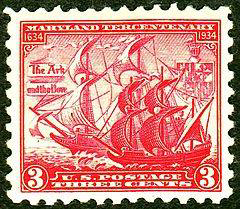
THE UNITED STATES, 1934, the 300th anniversary of Maryland, Scott 736
OTHER JESUIT ALLUSIONS |
The Ark & Fr. Andrew White, SJ

THE UNITED STATES, 1934, the 300th anniversary of Maryland, Scott 736
Father Andrew White (1579-1656) was born in England and schooled at colleges in England, Spain and France. After he became a Jesuit priest, he taught at two universities in France, coming secretly to England many times to visit Catholic friends. He went to work for Cecil Calvert, the second Lord Baltimore, who needed his help finding Catholic families to settle in his new colony, Maryland, where Father White wanted the Jesuits to establish a Catholic mission. In November 1633, he, his fellow priests and nine servants met the ship Ark at the Isle of Wight, just before it sailed for the New World. Father White kept a journal of this voyage called, Voyage into Maryland, which describes what life was like for the colonists on their four-month voyage and during the first months of their settlement. After stops in Barbados and Virginia, they landed, on March 25, 1664, near the mouth of the St. Mary's River. Father White celebrated Mass that day to thank God for their safe landing, thus becoming the first Catholic priest to offer Mass in the original 13 colonies. They made a treaty with the Yaocomico Indians for land at the mouth of the Chesapeake Bay, and built a new town called St. Mary's City. Father White studied the Native American languages, wrote a dictionary,and translated Catholic prayers into the native language. His mission ended in 1645 when Richard Ingle and his fellow Protestants raided St. Mary's, captured the Catholic priests and leaders of the colony, and brought them back to England, where he was jailed until a trial in January 1648 acquitted him of wrongdoing and released him. He died in England 8 years later. More
Fr.
Gabriel Gruber, SJ
(1740-1805)
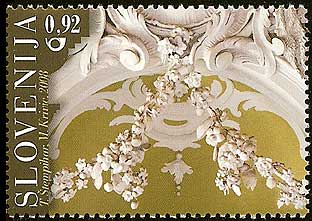
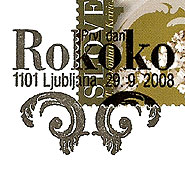
SLOVENIA, 2008, Rococo trim from inside the Gruber Palace (below), Scott
758 and its FDI cancel
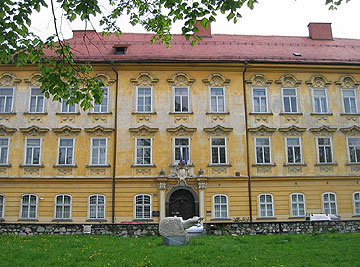
The stamp's motif is Rococo decoration from the Gruber Palace in Ljubljana, Slovenia, currently the home of the National Archives of Slovenia. It was built between 1773 and 1781 in a braided Baroque and Rococo style by Fr. Gabriel Gruber, SJ, an expert in hydrotechnology, optics and architecture. The palace was later named after him. Born in Vienna in 1740, he entered the Society at the age of 15 in 1755, and specialized in the sciences. After the Suppression of the Jesuits in 1773, Gruber continued as engineer at the court of Emperor Joseph II until 1784. Gruber Palace was originally his mansion, used for his research in physics and hydraulics. It also had an astronomic observatory. In 1784, Gruber rejoined the Jesuits, still in existence in Russia under the protection of Catherine the Great and helped make the college of Polatsk famous for the technical sciences. In 1802, just a few months after Pius VII had issued the brief, Catholicae Fidei, giving approval to the existence of the Jesuits in Russia, Gruber was elected the second superior general for Russia.
The Jamaica Credit Union Movement
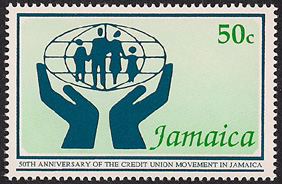

JAMAICA, 1992, 50th anniversary of the Credit Union Movement, Scott 780-781
Two stamps were issued in 1992 to celebrate the 50th anniversary of the Credit Union Movement in Jamaica. One carries an image of O'Hare Hall, the landmark building at St. George's College in Kingston, Jamaica in which the Jamaican Credit Union League was founded. In fact Jesuits had much to do with the movement. Father John Peter Sullivan, SJ, a member of the New England Jesuit Province, came to Jamaica in 1939 as teacher at St. George's College, pastoral minister at Holy Trinity Cathedral and moderator of a Catholic Young Men's Sodality (CYMS). He and the fourteen members of the Sodality studied the principles of credit unions, and on September 12, 1941, formed Jamaica's first credit union; the Sodality Credit Union. Father Thomas J. Feeney, Jesuit superior and president of St. George's College, developed an interest in the movement and assumed Sullivan's responsibilities at the college, allowing him the to promote the movement more widely. Fr. Harry Ball, SJ also shared interest in Sullivan's efforts and worked in Linstead and adjoining areas, Ewarton, Moneague, Jeffery Town, Guy's Hill and Donnington, as well as in Annotto Bay, Savannah-la-Mar and Alva. Sullivan formed credit unions on five Antillean islands: St. Lucia, Grenada, Curacao, Trinidad and Barbados. The Jamaica Credit Union League, a central cooperative body embracing all the credit unions in the island, was founded in 1942 in O'Hare Hall on the campus of St. George's College. With the establishing of this league headed by Father John Peter Sullivan, the movement now had an effective organization. Sullivan's work in the movement spanned almost two decades during which time the movement grew from 14 to 65,000 members and from an initial share capital of $1.87 to $6,000,000. He retired as active head of the Jamaica Cooperative Credit Union League at its 19th annual convention held at St. George's College in 1959.
Japanese Martyrs Shrine

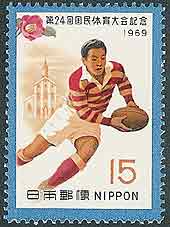
JAPAN, 1951, 1969 and 1981, Scott 535, 1017, 1464
JAPAN, 2009, the Second Ports Mini Sheet issued June 2 contained another image of the church, Scott 3120h
JAPAN, 2012, Travel Scenes in Nagasaki mini-sheet with the church to the top left of the stamps, Scott 3469
JAPAN, 17 November 2015 sheet marking 60th anniversary of local government law in Nagasaki Prefecture, Scott 3961
Twenty-six Christians were martyred in 1597 under the Taiko, Toyotomi Hideyoshi, ruler of Japan, among them three Jesuits: St. Paul Miki (1564-1597), St. John Soan de Goto (1578-1597), and St. James Kisai (1533-1597). They were beatified in 1627, and canonized in 1862. The place in Nagasaki where they were killed was declared an official pilgrimage site by the Pope Pius XII in 1950. The church on these stamps, the oldest wooden Gothic church in Japan, is commonly called Oura Tenshudo, but the official name is Nihon Niju-roku Seijin Junkyosha Tenshu-do (Church of the Heavenly Father for the Twenty-six Martyred Japanese Saints). A monument was erected there on the centenary of their canonization.
Father Joseph Liesganig, SJ
(1719-1799)
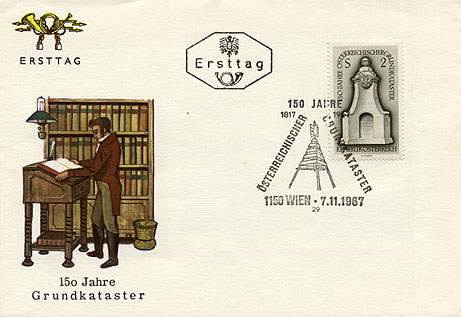
AUSTRIA, 1967, a land survey monument from 1762 with FDI cancel and cover, Scott 803
The monument bears the Latin inscription:
"At the behest of Their Majesties Franz and Maria Theresa
Joseph Liesganig, SJ, measured three degrees of arc of the meridian of Vienna
and erected this column at the north end of the baseline in 1762."Joseph Liesganig was born in Graz in 1719, died in Lvív, Ukraine in 1799. Liesganig, a mathematician, geographer and geodesist, was director of the observatory at the University of Vienna from 1756 to 1773. In 1759 he was commissioned by Maria Theresa, at suggestions from Boscovich, to survey the arc of meridian between Vienna and Brün. One purpose was to correct the maps of Austria. The greater purpose was a more accurate map of the world. The Jesuits with missions and observatories around the world had contributed greatly to this enterprise. In the attempt to determine the length of a degree of longitude, the Jesuits took a very prominent part: Boscovich and Maire in the Papal States, Christian Mayer in the Palatinate, Beccaria and Canonica in Italy, others in Abyssinia, South America, China, and the Philippines, and of course, Liesganig in Austria.
The National Library of Spain
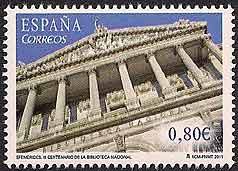
SPAIN, 2011, the tercentenary of the National Library of Spain, Scott 3815

SPAIN, 1916, private issue of the Spanish Parliament, Edfil FA 11 and 16Because he was a foreign-born monarch, Philip V, King of Spain, wanted to ensure support for his reign by demonstrating his solidarity with Spanish culture and character. The Biblioteca Real (the Royal Library) planned in 1711, began to function in 1712, and helped to revive the Spanish Golden Age that thrived under the Hapsburgs. Becoming in 1836 a national library, La Biblioteca Nacional de España, it has remained a keystone for Spanish culture throughout the world. To initiate and manage the library, the king appointed his Jesuit confessor, Father Pierre Robinet, SJ, a French theologian, to head the institution. When Robinet had to leave Spain in 1715; his successor, both as royal confessor and head of the royal library, was another French Jesuit, Father Guillaume Daubenton, SJ, a philosopher and seminary administrator. In fact during the first fifty years the directors general of the library were mostly Jesuits: Pedro Robinet, SJ, (1712-1715), Esteban Lecompaseur, SJ,(1715) Guillermo Daubenton, SJ,(1715-1723), Guillermo Clarke, SJ (1726-1743), Francisco Rávago, SJ (1751). The first head librarians, Gabriel Álvarez de Toledo, SJ (1712-1714) and Juan Ferreras, SJ (1715-1735),were also Jesuits. The 1916 Cervantes issue was a private issue of the two houses of the Spanish Parliament for their own use; no values were assigned to the stamps nor was the issue really needed since both houses at the time enjoyed franking privileges.
The Ozamiz Cotta
& Fr. Jose Docus, SJ
PHILIPPINES, 2006, the 250th anniversary of the Ozamiz Cotta (fort), Scott 3055
The stamp shows the historical marker that tells of the foundation of the fort by Fr. Jose Docus, SJThe Jesuits had worked in Mindanao for two centuries before their expulsion. They became active in Misamis in a somewhat strange manner. Frequent incursions of Muslims pirates, sometimes numbering 2,000 men in 20 ships, preyed upon the coastal communities of the Philippines burning homes and churches, destroying crops and taking people to be sold as slaves either in Malaysia or Indonesia. To prevent these threats, and to provide shelter for the ships of the Spanish fleet during that time, the government in 1754 organized a naval armada to patrol the Mindanao Sea and Fr. Jose Docus, SJ who was the missionary in Iligan was placed in charge as the captain general of the armada.
In 1756 Docus constructed the cotta or fort at Misamis whose ruins we see today, and named the fort in honor of Our Lady of Victory (Triunfo). His flagship was also called the Triunfo in commemoration of the victory over the Moors at the Battle of Las Navas de Tolosa in 1212. The Cotta or Fort developed into a Jesuit mission until they were expelled from the Philippines and it has been used uninterruptedly as a military stronghold ever since it was built until now. It is situated southeast of Misamis, now renamed Ozamiz City.
Paso del Molino, Montevideo, Uruguay
& Fr. Cosme Agulló, SJ
(1710-1772)
URUGUAY, 1998, the 250th anniversary of Paso del Molino, Scott 1774
This stamp celebrates the foundational event in 1748 that began the area of Montevideo called Paso del Molino (Mill's Crossing). That event was the building of a flour mill by Jesuit priest Cosme Agulló, the superior of the Jesuits in Montevideo and founder in 1745 of the Estancia of Nuestra Señora de los Desamparados, also called La Calera. The Cabildo of Montevideo had approved in December of l747 the Jesuit's request to put up the mill and ceded him land for it on the Miguelete River. Until then, the flour used in San Felipe y Santiago de Montevideo came from Buenos Aires. Agulló taught the small farm owners in the area how to raise wheat for the mill, and the community known as Paso del Molino grew centered around the mill. By 1870 the Jesuit had long been expelled and expanding city of Montevideo had engulfed the community. It has now become a most important neighborhood of Montevideo. The Gran Hotel del Paso del Molino, seen on the stamp, played a major role in this later development of the area.
The Philippine Constitution of 1987
& Fr. Joaquin G. Bernas, SJ
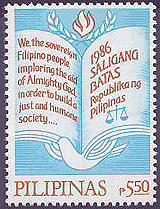
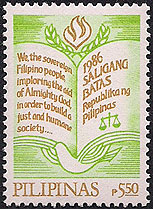
PHILIPPINES, 1987, the preamble to the 1986 Philippine Constitution, Scott 1850
The stamp was reissued the same year in a different color, Scott 1905.
This reissue was withdrawn from sale when forgeries were found being sold openly in several big post offices in Metro Manila. The forgeries are are rouletted instead of perforated.
In 1989 the reissue was surcharged, Scott 2005
The Catholic Church helped support Corazon Aquino who replaced Marcos as president of the Philippines. Aquino then initiated a new constitutional commission to frame the new 1986 Philippine Constitution. She appointed forty-six constitutional commissioners including Father Joaquin G. Bernas, SJ, a renown expert in the Philippine constitution. More
Saint Rosalia, Patron of Palermo
The Feast of Saint Rosalia in Palermo commemorates the saving of the city from the plague in 1624 through the intervention of the saint, which then elected her its patron saint. Legend has it that while the fever was ravaging the town the mortal remains of the saint were discovered through a vision and when they were brought in solemn procession on 6 June 1625 to Palermo's cathedral the plague ceased to rage on the population. But the cult of Saint Rosalia may never have existed without the Jesuits, who authenticated the remains, promoted her cult and canonization 26 January 1630, and strongly supported Cardinal Doria in naming her patron of Palermo. Her main hagiographer was the Jesuit Fr. Giordano Cascini whose work was published posthumously with many notes of another Jesuit, Fr. Pietro Salerno. The work was used by the Bollandist Fr. John Stilting for the Acta Sanctorum. Anthony van Dyke created a series of images of her for the Jesuit church at Antwerp. Her feast is celebrated July 15.
The Kingdom of Sedang
& The Imprimerie Jesuit, Haiphong

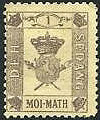
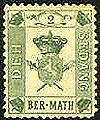
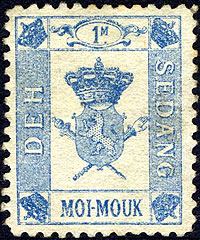

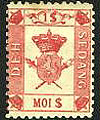
Cinderellas of the "Kingdom of Sedang," 1888Charles-Marie David, born in Toulon in 1842, after a number of what seems to have been incidents of fraud, made his way up the Mekong River and talked local tribes into making him king. Then, putting together all the paraphernalia of a kingdom, including these stamps, he tried to sell the kingdom in Europe. No one bought it. The "kingdom" fell apart in 1890 when David died under unusual circumstances. Above is the first issue of stamps of the Kingdom of Sedang printed in 1888. It is not clear where it was printed, though some sources indicate it was lithographed by the "Imprimerie Jesuit, Haiphong." Was there such a printery? And were the stamps printed by Jesuits, or is that all part of the great make-believe story surrounding this issue?
The Tower of London

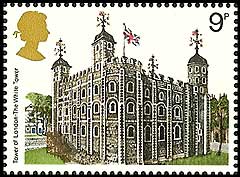
GREAT BRITAIN, 1978, the London 1980 International Stamp Exhibition,
Scott 834aScott 831a, 831
In the latter half of the 16th century, the Catholic Church was outlawed in England and many Roman Catholics were arrested, imprisoned, tortured and executed. Many Jesuit priests who were leading the mission to maintain and restore the Catholic faith in England spent their last days in the Tower of London. In a number of cells where these men were imprisoned the walls of the Tower bear the monogram of the Society — an IHS, the H surmounted by a cross. Among their number were:
| Blessed Ralph Ashley, SJ ( ?-1606) | Saint Thomas Garnet, SJ (1575-1608) |
| Saint Alexander Briant, SJ (1556-1581) | Saint David Lewis, SJ (1616-1679) |
| Saint Edmund Campion, SJ (1540-1581) | Blessed Edward Oldcorne, SJ (1561-1606) |
| Blessed Thomas Cottam, SJ (1549-1582) | Saint Nicholas Owen, SJ (1550-1606) |
| Saint Philip Evans, SJ (1645-1679) | Saint Robert Southwell, SJ (1561-1595) |
| Fr. Henry Garnet, SJ (1555-1606) | Saint Henry Walpole, SJ (1558-1595) |
Fr. John Gerard, SJ (1564-1637), after excruciating torture managed to escape from the Tower, the only Jesuit to do so, and lived to write the story of his life, The Autobiography of an Elizabethan, which details the recusant world of secret Masses, priest-holes, religious persecution and torture.
In May 2006 the British Province marked the 400th anniversary of the martyrdom of four English Jesuits—Ralph Ashley, Henry Garnet, Edward Oldcorne and Nicholas Owen—with a service in the Tower's Chapel of St. Peter ad Vincula just a few feet from the place of execution. Permission to use the chapel rests solely with the sovereign, and Queen Elizabeth II graciously gave her consent. The tower authorities extended a most warm welcome. Times have changed.

URUGUAY, 1979, a souvenir sheet for the centenary of the death of Sir Rowland Hill
including Great Britain's Tower mini-sheet to the left, Scott C439
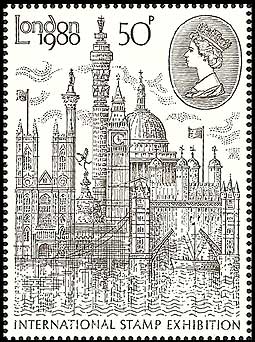
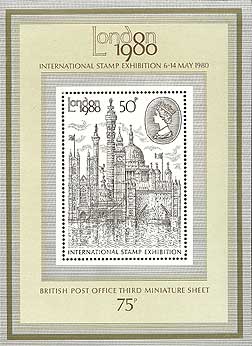
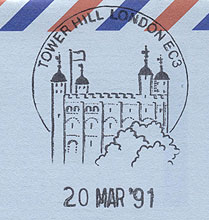
GREAT BRITAIN, 1980, the International Stamp Exhibition, Scott 909 and
909a
GREAT BRITAIN, 1991, cancel from Tower Hill, London
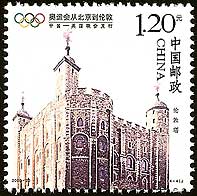
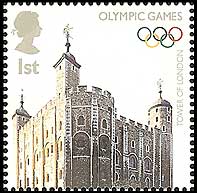
CHINA, 2008, Olympic Games joint issue, Scott 3699
GREAT BRITAIN, 2008, Olympic Games joint issue, Scott 2593c
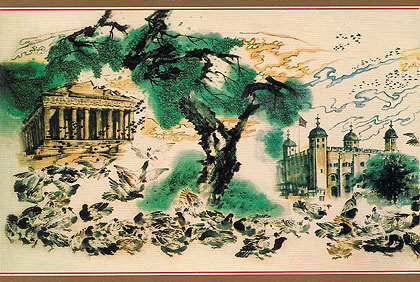
CHINA, 2008, postal card showing the Tower of London
The Virgin's Tree, Mataria, Egypt
& Fr. Michel Jullien, SJ
EGYPT, 1967, International Year of TourismThe oldest and the most likely tradition about where the Holy Family visited in Egypt is Mataria, near ancient Heliopolis, six miles from Cairo. There, in what's known as the "Garden of Herbs," stands the Virgin's Tree, an Egyptian sycamore. Although probably less than 300 years old, its age seems far greater. It is revered by Muslims and Christians who believe the Holy Family rested there and that as the feet of Jesus touched the earth two springs of sweet water sprang up, which still exist. After the French Jesuits returned to Egypt in 1879, they established a residence near the place. Fr. Michel Marie Jullien, SJ, born in 1827 in Lyons of a very large family, an historian, mathematician, and provincial superior, who worked in Egypt from the early 1880's until his death, built the Church of the Holy Family close by the tree to accommodate the many pilgrims. The flight into Egypt is depicted in six murals on its walls. In 1905 he authored A Visit to the Virgin's Tree: Souvenirs of the Holy Family's Sojourn at Mataria, which describes the legend and the environs, and at his death in 1911 he was buried in the Jesuit burial ground adjacent to the church he founded. Jullien had also purchased the land on which the Jesuit Collège de la Sainte-Famille in Cairo now stands.
Collaborator with Nicholas Yapuguay
PARAGUARY, 2012, the 125th anniversary of the National Library featuring a book written
by the first native author Nicholas Yapuguay "with the direction of a religious of the Society of Jesus"On the occasion of the 125th anniversary of its National Library, Paraguay features a book, Sermones y ejemplos en lengua Guaraní by Nicolas Yapuguay Paraguay's first Indian author. It was published in the town (reduccion) of St. Francis Xavier in 1727. The title says it was written "with the direction of a religious of the Society of Jesus" and while unnamed he was arguably Fr. Pablo Restivo, SJ, who did much other work in this field and who probably preached most of the original sermons on which this work is based.